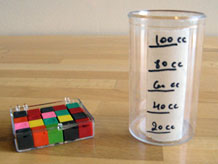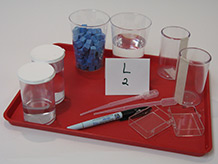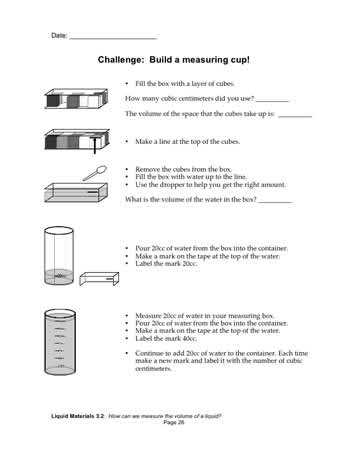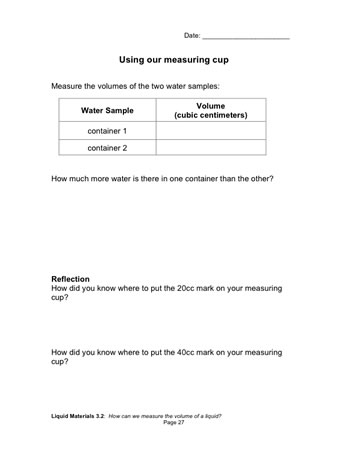How can we measure the volume of a liquid?
Plan Investigation 3.2

Minutes … Inches … Grams … Square feet … Most fourth graders have a passing familiarity with measures of time, length, weight, and area. But cubic centimeters? What are those?
In the last session, students discovered that they can't reliably compare liquid volumes using only their senses. In this investigation they get a hands-on introduction to cubic centimeters, a common unit of volume used by scientists. They then make and calibrate their own measuring cups and use them to measure some water volumes.
By the end of this investigation students will appreciate the usefulness of a standard unit of volume, become familiar with centimeter cubes, begin to associate these objects with equivalent amounts of space, and be able to compare liquid volumes with accuracy.
Learning Goals
- Become familiar with the volume of a centimeter cube
- Figure out how to make a measuring cup for liquids
- Begin to estimate volume in cubic centimeters
| Sequence of experiences | ||
|---|---|---|
| 1. Ask the question | All Class | 5 Mins |
| 2. Explore centimeter cubes | Small Groups | 10 Mins |
| 3. Make a measuring cup | Pairs | 20 Mins |
| 4. Make meaning | Discussion | 10 Mins |
Materials and Preparation
For the class:
- Post the investigation question in a place where all students can see it.
- 20-25 centimeter cubes for your class demonstration

For each tray:
- 1 capped 150cc container approximately 1/2 full of water
- 1 capped 150cc container approximately 3/4 full of water
- 2 empty 150cc containers with a vertical strip of masking tape applied to the outside *
- 2 small rectangular plastic containers
- 2 pipettes
- 2 20oz cups approximately 1/2 full of water
- 1 fine tip permanent marker
- 1 cup holding approximately 75 centimeter cubes (these cubes will be handed out separately, before the rest of the tray)
*Student-made graduated cylinders will be used again Investigation 4.3.







